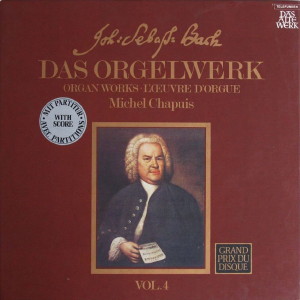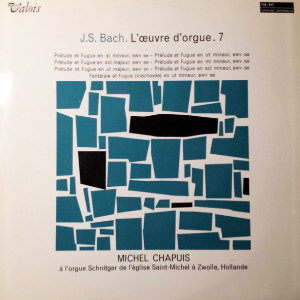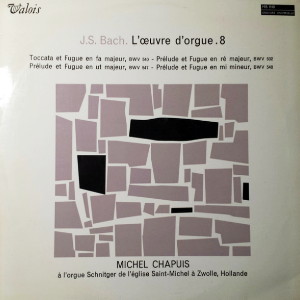 |
|
2 LP's
- BC 25101-T/1-2 - (p) 1968
|

|
| 1 LP -
Valois MB 847 - (p) 1968 |
 |
| 1 LP -
Valois MB 848 - (p) 1968 |
|
| DAS ORGELWERK -
VOL. 4 |
|
|
|
|
|
| Johann
Sebastian Bach (1685-1750) |
|
|
|
|
|
| Long Playing
1 - (Valois MB 847) |
|
|
| Präludium und
Fuge h-moll, BWV 544 |
11' 08" |
|
| Präludium und
Fuge c-moll, BWV 549 |
5' 11" |
|
| Präludium
und Fuge G-dur, BWV 550 |
6' 20" |
|
|
|
|
| Präludium
und Fuge e-moll, BWV 533 |
5' 00" |
|
| Präludium
und Fuge C-dur, BWV 531 |
5' 41" |
|
| Präludium
und Fuge g-moll, BWV 535 |
7' 13" |
|
| Fantasie
und Fuge (Fragment) c-moll,
BWV 562 |
6' 34" |
|
Long Playing
2 - (Valois MB 848)
|
|
|
| Präludium
(Toccata) und Fuge F-dur, BWV
540 |
14' 00" |
|
| Präludium
und Fuge D-dur, BWV 532 |
9' 52" |
|
|
|
|
| Präludium
und Fuge C-dur, BWV 547 |
8' 45" |
|
| Präludium
und Fuge e-moll, BWV
548 |
14' 04" |
|
|
|
|
| Michel Chapuis |
|
| an
der Arp Schnitger-Orgel
der St. Michaelis-Kirche,
Zwolle/Holland |
|
|
|
|
|
Luogo
e data di registrazione |
|
Zwolle
(Olanda) - luglio 1968 (LP 1)
& agosto 1968 (LP 2) |
|
|
Registrazione: live /
studio |
|
studio |
|
|
Producer / Engineer |
|
Michael
Bernstein |
|
|
Prima Edizione LP |
|
- Valois
- MB 847 · Vol. 7 - (1 LP) -
durata 47' 07" - (p) 1968 -
Analogico
- Valois - MB 848 · Vol. 8 - (1
LP) - durata 46' 41" - (p) 1968 -
Analogico
|
|
|
"Das Orgelwerke" LP |
|
Telefunken
- BC 25101-T/1-2 - (2 LP's) -
durata 47' 07" / 46' 41" - (p)
1968 - Analogico |
|
|
Note |
|
- |
|
|
|
|
|
Bach’s
artistic development is
effected first of all in
organ music and in what,
initially, was piano music
of a style that scarcely
differed from it. After
passing through the Latin
school in Ohrdruf and Lüneburg,
and then taking a brief
temporary post as violinist
in the Weimar court
orchestra, he became
organist at the new church
in Arnstadt in 1703 at the
age of 18; he had shortly
before inspected and
inaugurated the church’s new
organ. In 1707 he
transferred his organist’s
activities to the larger
organ at St. Blasius Church
in Mühlhausen,
and a year later became
“Organist and Kammermusicus”
at the Court of Weimar. At
least until early 1714, when
he was appointed leader and
regularly had to compose and
perform cantatas, he was
primarily occupied with his
organist’s duties. Thus in
the eleven years between
1703 and 1714 most of his
organ works were composed
which form chorale
arrangements “bound” to a
hymn tune, as well as the “
free” organ works consisting
mainly of the preludes and
fugues.
We do not know the exact
dates of when the individual
works were composed;
instead, starting from the
few works which can be given
a precise date, we have to
draw conclusions as to the
sequence of the remainder.
In this respect, source
research and analysis of
style complement each other.
With a certain amount of
reservation, the tone volume
of the pieces also provides
some indications as to time;
for the organs which Bach
played in Arnstadt, Mühlhausen
and Weimar differed with
regard to the extent of the
pedal and keyboards.
However, this type of
investigation takes us back
only as far as the Arnstadt
period. Which works Bach had
already taken there with
him, to what degree he was
already independent as a
composer at the age of 18 is
something of which we are
not aware. Nevertheless, in
those works capable of
dating we can already
observe an astounding
development, both in style
detail and in the formal
arrangement. In the early
works the harmonic
modulation makes an erratic
in inconstant impression,
not yet being used in a
planned manner for the
tension-laden construction
of major forms. The basses,
at first dependent supports
for the melody, are
gradually given a more
independent role and
establish the immediate
compositional continuity.
Bach arranged thematically
and enlivened the sequences,
that is to say the frequent
repetitions of the same
theme-figure in a different
tone degree. This process
would have been
inconceivable without Bach’s
disputation with
contemporary Italian music.
From now on Bach
incorporated its song-like
quality in his own
instrumental music. This
already becomes apparent in
his fugue themes. They are
carried in vocal style and
eschew what until then had
been the somewhat obstrusive
instrumental figuration
which he had learned from
North German models. He took
over from the new Italian
solo concerto the generously
proportioned and clearly
structured formal
arrangement, based on the
change from pithy ritornello
thematic and richly
contrasting solo episodes by
way of a broadly spread
harmonic basic outline.
Bach’s fugues are affected
by this as much as the
preludes. Over and above
this he perfected what was
probably his inborn gift of
combination, his
contrapuntal art. The organ
works in the present series
provide examples from his
various stages of
development, from the
carefree toccata-like pieces
which open with a dash from
the Arnstadt era, to the
grand Leipzig organ works.
A fair copy manuscript by
Bach of the Prelude and
Fugue, B minor, BWV 544,
from around the year 1730
has been preserved. The work
itself was undoubtedly
composed only a short time
previously since it bears
all the traits of Bach’s
mature art. In the
concerto-style constructed
prelude in 6/8 time, a long,
fantasia-type ritornello
alternates three times with
a fugal episode. The two
passages are transformed in
the recurrence. The sections
of the ritornello are
transposed and extended
thematically, the episode
shortened and contrapuntally
more tightly-knit. The fugue
contrasts with this complex
prelude not only in the
theme style, but even more
on account of the uniformity
of its material and motion
form. The theme, which in
quaver movement paraphrases
the rising triad tones and
again leads back to the
ground tone, also dominates
the intermezzos with the
subsequent counterpoint. A
long manualiter centre part
provides the necessary sound
contrast.
Prelude and Fugue, C
minor, BWV 549 are
among the earliest of Bach’s
works to be passed on to us.
The original version was in
D minor, and we do not know
whether
that generally played at the
present time in C minor was
not perhaps a posthumous
arrangement for an organ the
pedal of which extended only
as far as c’. As in many
other youthful works by
Bach, the prelude begins
with a pedal solo and in
simple intensification by
way of organ points leads
quickly to the conclusion.
The fugue, with its long and
somewhat obstrusive
descending cadenza theme,
links up with the prelude.
The pedal entry is reserved
for the conclusion of the
second development. A long
virtuoso coda in particular
shows that in this case the
old multi-part toccata
served as a pattern, in
which the virtuoso-figurative
sections alternate with
fugal parts.
Prelude and Fugue, G
major BWV 550, like
many other G major pieces by
Bach, radiate light-hearted
joy. Shadows are almost
completely absent, and it
requires considerable
interpretative stamina to
prevent this piece,
extremely long in relation
to its simple construction,
having a wearying effect.
The fugue theme, with its
upbeat repetitive crotchets
and its counterbeat broken
triads is headed “alla breve
e staccato”: for this reason
it must not be gracefully
played down. With graduated
entries starting from the
top, the prelude first moves
on to a long pedal solo and
then in reverse sequence
builds up on this an
intensified section. A short
modulation middle section
has the task of once more
diverting attention from the
principal key already
reached in order to prepare
for entry of the fugue in
the dominant. Judging
from its style, the work
dates back to the Weimar
period.
It is scarcely possible to
conceive a greater contrast
than between this piece and
the short Prelude and
Fugue, E minor, BWV 533,
a youthful work which
touches us with the warmth
of its feeling. The
development thématique of
the prelude, a harmonically
rich movement, gives prior
notice of Bach’s art of
consistently further
developing a concept. Here
it is a case of heightening
the syncopes to sharp
counterbeats and forming the
conclusing with the “below
stairs figure” of the bass.
Both concepts emerge
voluntarily from the
preludes, gain firm shape by
repetition and show in the
process how improvisation
fuses into composition. The
fugue dispels any thought of
strictly observed theme
technique. As in a long
drawn out aria, the
counterpoints incorporate
the theme - clearly jointed,
but nevertheless avoiding
any clear break.
Prelude and Fugue, C
major, BWV 531 is
certainly one of the very
earliest works. We recognize
this not only from various
stylistic deficiencis, which
probably disturb the eye
more than the ear, but even
more clearly from the
disproportion between the
boldly forward-moving
impulse of the themes, and
the still little developed
shaping strength. Thus,
great arcs of tension are
built up but do not follow
through. In the final
analysis it is the player,
who with his momentum, has
to join the pieces together
into a whole, and not the
music of itself compelling
the unity of the whole.
Young Bach will have
fascinated his listeners
with these pieces, but he
himself was the first to
recognize their
shortcomings. His studies of
foreign examples,
particularly of the Italian
masters, but also his own
formal experiments spread
over many years, appear to
have been directed towards
developing the possibilities
which accorded with his
inventive powers in order to
construct larger, more
compelling forms.
Among the very few youthful
Works of Bach which have
come down to us in autograph
form are the Prelude and
Fuge, G minor, BWV 535.
According to Bach’s written
characters in the famous “Möller
Manuscripts”, the main
source of information for
Bach’s early works, this
effective piece must have
been composed in the middle
Arnstadt years, certainly
not later than 1706. At that
time, however, the prelude
was of a much more modest
shape and was scarcely half
as long. Above all the
14-bar long chromatic
sequence was missing,
leading from F-sharp in
semitone steps by way of a
tenth down to D. Similarly
Bach did not compose until
later the accord at the head
of the fugue theme in the
pedal part, bars 10 to 11 of
the prelude: It is only this
tension-laden anticipation
that motivates the long
sequence. The fugue on the
other hand required only
little alteration. It is a
text book example of how a
significant theme also
dictates the appropriate
arrangement.
We are also able to trace
the origins of the Fantasia
C minor, BWV 562 and
its fragmentary Fugue on the
basis of the autograph. The
Fantasia originates from the
beginning or the middle of
the 1730’s.
It was not until much later,
in the 1740’s, that Bach
composed the Fugue to go
with it, but apparently did
not complete it. The present
recording ends with the
dominant cadence after the
first exposition. In the
manuscript, which breaks off
five bars later, the
beginning of a stretto
follows, and it can be
assumed that further
contrapuntal combinations,
perhaps also the
introduction of a second
theme, were planned.
Compensation for this torso
is provided in the shape of
the Fantasia, which in its
own right is an incomparable
work: devoid of all external
outbursts. the tightlywoven
but always vocal imitative
movement has the effect of
music which requires no
intermediary, but which
appeals directly to the
senses.
Toccata and Fugue, F
major, BWV 540 have
been handed down separately
in various manuscripts, and
it is quite possible that
Bach compiled these two
inordinately long movements
only subsequently to this
monumental pair of
movements. The toccata
originates from the middle
Weimar period. It combines
the grand lucid
concerto-type arrangement
with long toccata-style
developments by way of the
organ point and with
extensive pedal solos. The
exposition is repeated on
the dominant. From the
cadence chords which
concludes them Bach gains a
sequence motif which is now
carried on in alternation
with a new theme and the
thematic material of the
exposition. The fugue was
probably composed later. Its
chromatically introduced
ricercare theme is
confronted in a centre
section manualiter with a
second, more playful theme,
which in the final part is
brought together with the
principal theme.
The Prelude and the
Fugue, D major, BWV 532
were probably originally
composed independently of
each other. The sources say
nothing about the time of
their composition, but
judging from the style they
are early works, going back
to the Arnstadt era. The
fugue is the virtuoso
brilliant work among the
youthful pieces. With the
obtrusive caesura of the
long figurative theme Bach
carries out a practical joke
and plays with a blustering
counterpoint into the pause
between the fore movement
and continuation of the
theme. An earlier version of
the fugue was considerabyl
shorter. In the final
version Bach better disposes
of the individual voices and
extends the second part. The
prelude accords with the
formal model of a threepart
toccata. A chordal-figurative
introduction is followed by
a concertante “alla breve”,
in the Italian style, which
unconcernedly makes use of
sequence chains. An adagio
forms the coda.
Prelude and Fugue, C
major, BWV 547
originate from the middle
Leipzig period. Hardly any
other organ work of this
extent is so tightly-knit
and so consistently
renounces figurative
episodes, despite the
concerto-type arrangement.
Nevertheless the listener
scarcely notices this
combinative effort:
everything is lucidly
structured. The prelude with
its double exposition is
arranged in similar fashion
to the grand F major
Toccata, BWV 540, only that
it is very much more
concentrated. The fugue
reserves pedal use until the
last exposition and
processes the theme first in
similar motion, then in the
reversion. The fourth
exposition brings similar
and reverse form in stretto,
the fifth repeated stretti
via the augmented theme in
the pedal. Incidentally
one has the impression that
in this work Bach for a
definite reason consciously
kept the pedal part easier
than in others: both in the
Prelude and in the Fugue he
waives rapid passages.
Prelude and Fugue, E
minor, BWV 548 are, in
addition to the large-scale
movement pair in E-flat
major from the III.
part of the “Klavierübung”,
the most powerful of Bach’s
late organ works. According
to a part autograph, it will
also have been composed
towards the end of the 1730’s.
The prelude combines the old
figurative-chordal
mode of play of the toccata,
its development by way of
organ points, with clearly
structured concerto-style
construction. The fugue,
which from time immemorial
has been regarded as the
boldest and technically
most difficult of the Bach
fugues, is what is known as
a “da capo fugue”: after a
clearly contrasting centre
section the opening part is
repeated note for note. From
the tension-packed theme,
which is based on the
principle of interval
expansion, one can already
gain a picture of Bach’s
artistic development: it has
evolved entirely from the
idiom of the instrument,
already non-vocal on account
of the pendulum motion,but
at the same time possessing
the unity of his fugue
themes formed on the Italian
style.
by Georg
von Dadelsen
English
translation by
Frederick A. Bishop
|
|
|
Johann
Sebastian Bach - DAS
ORGELWERK
|
|
|
|

